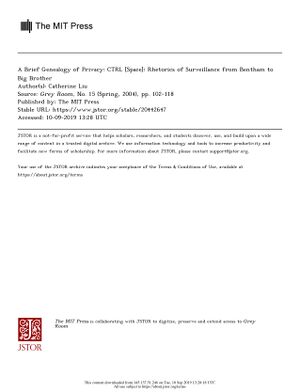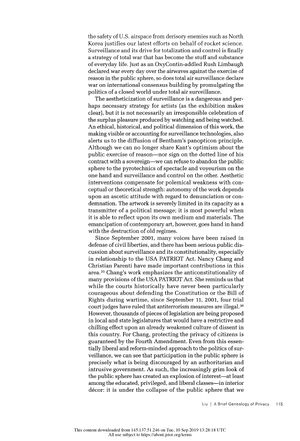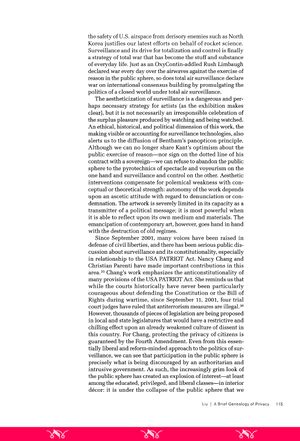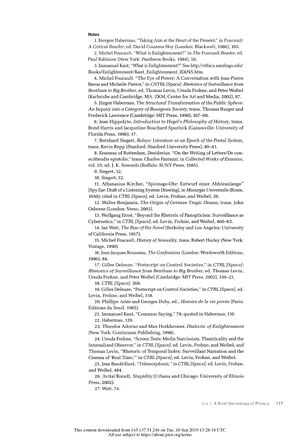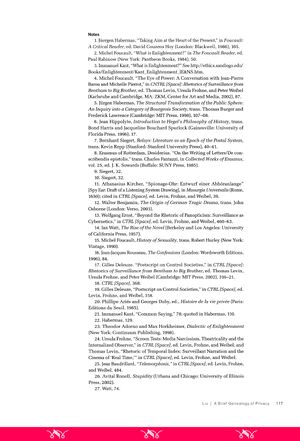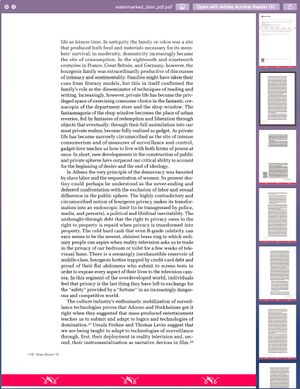User:Pedro Sá Couto/JSTOR pdf: Difference between revisions
No edit summary |
|||
| (2 intermediate revisions by the same user not shown) | |||
| Line 1: | Line 1: | ||
=Tactical Watermarks on a JSTOR pdf= | =Tactical Watermarks on a JSTOR pdf= | ||
<br> | |||
Watermarks are creating a body of evidence on users, adding traces that relate to the subject, more precisely with geolocation, IP addresses, mac addresses, email addresses, etc. A good example of this is phenomena is visible when downloading a pdf from JSTOR. We can understand that their watermarks are not supposed to pass unnoticed to its users. | Watermarks are creating a body of evidence on users, adding traces that relate to the subject, more precisely with geolocation, IP addresses, mac addresses, email addresses, etc. A good example of this is phenomena is visible when downloading a pdf from JSTOR. We can understand that their watermarks are not supposed to pass unnoticed to its users. | ||
| Line 18: | Line 19: | ||
I think I am almost able to check all these boxes above.<br> | I think I am almost able to check all these boxes above.<br> | ||
The way we are leaving imprints that identify us as downloaders and printers is alarming. In this exercise I created a way of tactical watermarking where I am able to obscure all previous watermarks left. You can see a logo at the end of every page now left by me. It is not only a way to obscure it. I could have just cropped the images but also of leaving a visual comment of my action. | The way we are leaving imprints that identify us as downloaders and printers is alarming. In this exercise I created a way of tactical watermarking where I am able to obscure all previous watermarks left. You can see a logo at the end of every page now left by me. It is not only a way to obscure it. I could have just cropped the images but also of leaving a visual comment of my action.<br><br><br> | ||
[[File:target-11.jpg|300px|REGULAR DOWNLOAD]] | [[File:target-11.jpg|300px|REGULAR DOWNLOAD]] | ||
| Line 33: | Line 33: | ||
[[File:arrow_after.jpg|30px]] | [[File:arrow_after.jpg|30px]] | ||
[[File:target-17.jpg|300px|Watermarked DOWNLOAD]] | [[File:target-17.jpg|300px|Watermarked DOWNLOAD]] | ||
<br> | |||
[[File:full_watermarked.jpg|thumb|Fully Watermarked PDF|right]] | |||
Latest revision as of 12:19, 4 December 2019
Tactical Watermarks on a JSTOR pdf
Watermarks are creating a body of evidence on users, adding traces that relate to the subject, more precisely with geolocation, IP addresses, mac addresses, email addresses, etc. A good example of this is phenomena is visible when downloading a pdf from JSTOR. We can understand that their watermarks are not supposed to pass unnoticed to its users.
Their strategy is to append our IP address, the time of the download and they are also leaving a link to Jstor terms and conditions.
On this link you can read:
- 5. Prohibited Uses of the Content
- (c) attempt to override, circumvent, or disable any encryption features or software protections employed in the JSTOR Platform;
- (d) undertake any activity such as the use of computer programs that automatically download or export Content, commonly known as web robots, spiders, crawlers, wanderers or accelerators that may interfere with, disrupt or otherwise burden the JSTOR server(s) or any third-party server(s) being used or accessed in connection with JSTOR; or
- (e) undertake coordinated or systematic activity between or among two or more individuals and/or entities that, in the aggregate, constitute downloading and/or distributing a significant portion of the Content; or
- (f) make any use, display, performance, reproduction, or distribution that exceeds or violates these Terms and Conditions of Use.
- Additionally, for Content other than the Early Journal Content, Institutions and users may not:
- (g) modify, obscure, or remove any copyright notice or other attribution included in the Content;
- (h) incorporate Content into an unrestricted database or website, except as provided in 4.1(e) above;
I think I am almost able to check all these boxes above.
The way we are leaving imprints that identify us as downloaders and printers is alarming. In this exercise I created a way of tactical watermarking where I am able to obscure all previous watermarks left. You can see a logo at the end of every page now left by me. It is not only a way to obscure it. I could have just cropped the images but also of leaving a visual comment of my action.

